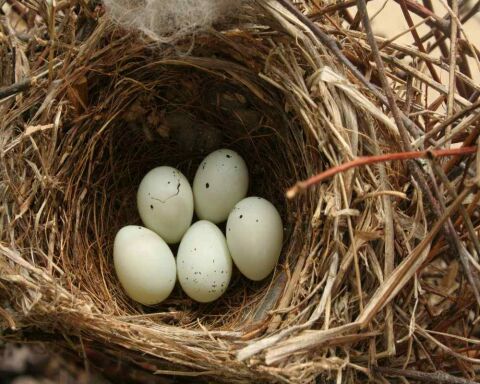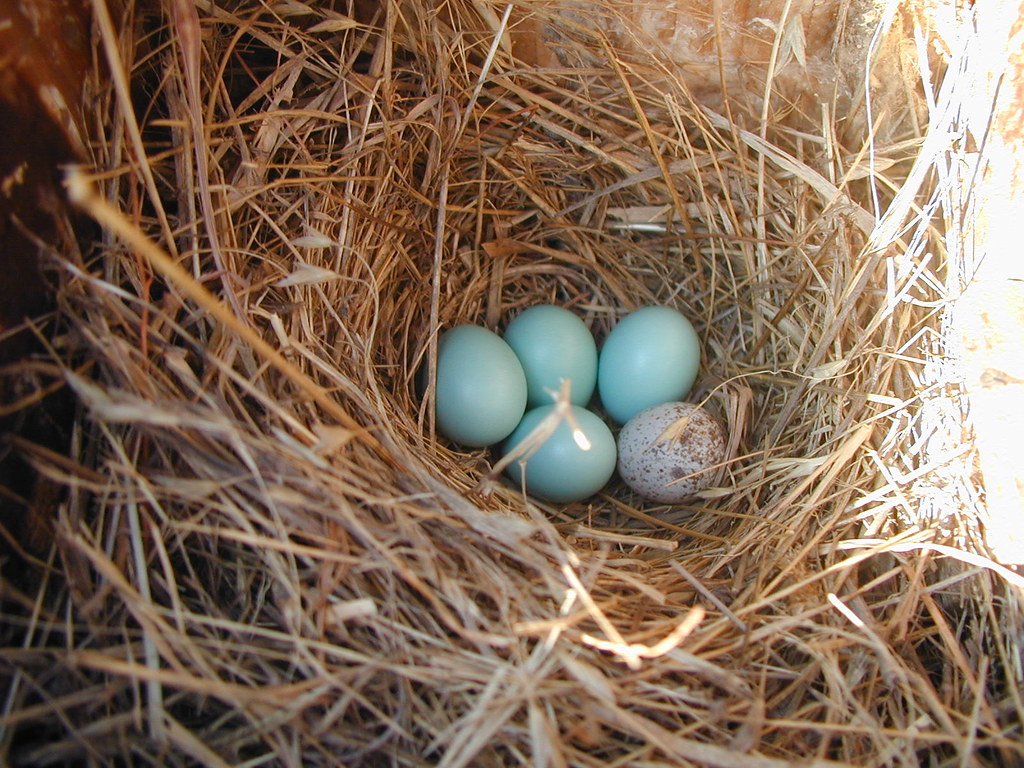

The male has a dark grey crown from the top of its bill to its back, and chestnut brown flanking its crown on the sides of its head. The sexes exhibit strong dimorphism: the female is mostly buffish above and below, while the male has boldly coloured head markings, a reddish back, and grey underparts. The plumage of the house sparrow is mostly different shades of grey and brown. Birds at higher latitudes, colder climates, and sometimes higher altitudes are larger (under Bergmann's rule), both between and within subspecies. Younger birds are smaller, males are larger during the winter, and females are larger during the breeding season. The median mass on the European continent for both sexes is about 30 g (1.1 oz), and in more southerly subspecies is around 26 g (0.92 oz). Females usually are slightly smaller than males. In mass, the house sparrow ranges from 24 to 39.5 g (0.85 to 1.39 oz). Wingspan ranges from 19–25 centimetres (7.5–9.8 in). Its bill is stout and conical with a culmen length of 1.1–1.5 cm (0.43–0.59 in), strongly built as an adaptation for eating seeds.
#House sparrow eggs full
The house sparrow is a compact bird with a full chest and a large, rounded head.

The house sparrow is typically about 16 cm (6.3 in) long, ranging from 14 to 18 cm (5.5 to 7.1 in).

The animal's conservation status is listed as least concern on the IUCN Red List.Īn audio recording of a house sparrow Description Measurements and shape Though it is widespread and abundant, its numbers have declined in some areas. It has also often been kept as a pet, as well as being a food item and a symbol of lust, sexual potency, commonness, and vulgarity. It is extensively, and usually unsuccessfully, persecuted as an agricultural pest. However, it is an opportunistic, omnivorous eater, and commonly catches insects, their larvae, caterpillars, invertebrates and many other natural foods.īecause of its numbers, ubiquity, and association with human settlements, the house sparrow is culturally prominent. For sustenance, the house sparrow routinely feeds at home and public bird feeding stations, but naturally feeds on the seeds of grains, flowering plants and weeds. Though found in widely varied habitats and climates, it typically avoids extensive woodlands, grasslands, polar regions, and hot, dry deserts far away from human development. The house sparrow is strongly associated with human habitation, and can live in urban or rural settings. Its intentional or accidental introductions to many regions, including parts of Australasia, Africa, and the Americas, make it the most widely distributed wild bird. One of about 25 species in the genus Passer, the house sparrow is native to most of Europe, the Mediterranean Basin, and a large part of Asia. Females and young birds are coloured pale brown and grey, and males have brighter black, white, and brown markings. It is a small bird that has a typical length of 16 cm (6.3 in) and a mass of 24–39.5 g (0.85–1.39 oz). The house sparrow ( Passer domesticus) is a bird of the sparrow family Passeridae, found in most parts of the world. But for Western and Mountain Bluebirds, you’ll just need to remove the predator guard over the entrance hole or replace it with this larger predator guard to ensure an adequate entrance hole size of 1 9/16 inches.Passer arboreus Bonaparte, 1850 ( preoccupied) Note: This box works for Eastern, Western, and Mountain Bluebirds. The best price I’ve found for this birdhouse is on Amazon. The see-through viewing window will add a layer of protection between you and the baby bluebirds when you sneak a peek to monitor the nest box.

Then, my favorite aspect of this box is the easy, side-opening door that leads to a viewing window. The mesh liner at the bottom of the nest is a unique innovation in nest boxes that is designed to protect the young bluebirds from blowfly larvae, which can sometimes be a problem. The ventilation holes on the on the top and drainage holes on the bottom will help protect your birds from the summer heat and excess moisture in the nest. A viewing window between the door and the inside of the nest box.A stainless steel mesh liner on the bottom of the box to protect from blowfly larvae.This nest box has four features that I love which make it my top recommendation: My top bluebird house recommendation is the model CWH4 bluebird box by Nature’s Way.


 0 kommentar(er)
0 kommentar(er)
